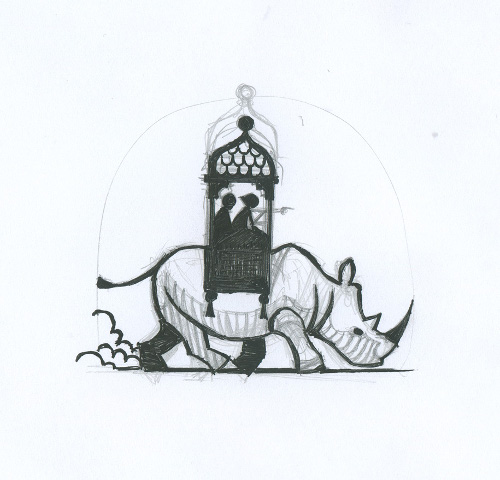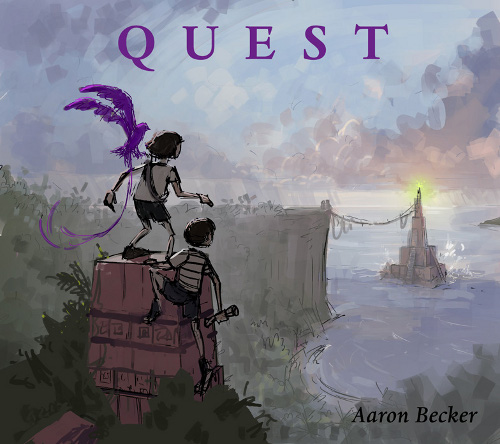One Breathtaking Quest Before Breakfast:
A Visit with Author-Illustrator Aaron Becker
 September 2nd, 2014 by jules
September 2nd, 2014 by jules
Pictured here is Aaron Becker’s sketch of the rhino that is embossed on the cover of Quest (Candlewick, August 2014), the second picture book in what Aaron calls the Journey trilogy. The trilogy began with last year’s Journey, which was awarded a Caldecott Honor.
I’ve told this story before, but my own journey with Journey began back in 2012 when Aaron left a comment here at 7-Imp, I clicked on his hyperlinked name, and I visited his website. I believe I muttered “whoa” a lot here at my desk at 7-Imp Central. (It was, most likely, more like “whoa, DUDE,” but that makes me sound way less professional, doesn’t it?) I asked him if he’d like to visit the blog, which resulted in this post a year before Journey came out (oh, and then this fun breakfast interview in 2013). Then, when it finally was released, I ended up blurbing it, which is something I don’t do on a regular basis, but I loved the book. When the book got a Caldecott Honor, I cheered loudly down here in Tennessee. And now … well, to see Quest finally on shelves is a bit thrilling if you’re a Journey fan.
Quest brings back to readers the boy and the girl of the previous tale, who embark one rainy day on a journey to save a king who has been captured. He surprises the children in the park, handing them a map and swearing them to secrecy, while setting them to the task of finding six magic crayons that will eventually free his kingdom from darker forces now in control. The Kirkus review notes that Becker’s storytelling here in the world he created with last year’s book is even more ambitious. I’ve read the book multiple times and see some new detail in each read, and I also love the bits of humor. (For one, during a glorious underwater scene, the purple bird from Journey can be seen with his own scuba tank. Becker is never one to miss details.)
It’s another wonderful (in the truest sense of the word) wordless tale. It’s breathtaking, thrilling, and epic all at once. At this Candlewick Q&A, Aaron goes into detail about how he creates his art; it involves computer 3D models of each element of the world he’s created. Today here at 7-Imp, he chats with me a bit and shares some preliminary images (dummy images, early cover art, etc.) And I thank him for visiting.
p.s. Don’t miss Matthew Winner’s August podcast conversation with Becker.
(Click to enlarge)
Jules: You’ve probably already discussed elsewhere what it was like to get the Caldecott call, so I apologize if this is redundant, but hey, what was it like to get the Caldecott call?
Aaron: I’ve had people tell me not to read anything on the internet about one’s book, but because I’m so new to this, I just can’t help myself. It’s exciting! So, I had read all of these blogs leading up to the Caldecott announcements saying how Journey was a major contender. So when the call came, I saw that it was from Philadelphia, and I had a pretty good idea who might be on the other end. That said, it was still a total thrill, and I think the more time that passes, the better I understand just how amazingly fortunate I’ve been.
(Click to enlarge)
(Click to enlarge)
(Click to enlarge)
Jules: How’d you deal with the pressure of creating both a sequel and a sophomore picture book when the success of your debut was so huge? This is assuming you felt stress. Perhaps you did not.
Aaron: Because the artwork for Journey was completed a full year and a half before it published, I had plenty of time to work on a follow-up before I had any idea that Journey was going to be so well-received. Well, I had your blurb, but you know … I didn’t want to just rest on my laurels, so I went ahead and developed the idea for an entire trilogy. The artwork for Quest was finished in early June of 2013, a few months before Journey published!
That said, I did feel some pressure when working on the series’ finale (Return, due Fall 2016) — not so much because of the success of its predecessor, but because I knew it had to do justice to the character arcs I had been developing. Like Quest, it had to have its own beginning, middle, and end, but unlike the second book, it also had to finish the entire tale. I spent probably nine or ten months on the story alone and am just now starting to finish the artwork for it.

Jules: Ah, I see. I had planned on asking if work on the third book in the trilogy has already begun.
Aaron: After much wrangling, the story is DONE. But the artwork awaits. My family and I are headed to Spain for the school year, and Candlewick has agreed to ship me all of my supplies to finish the artwork right on the Mediterranean. How cool is that?!
Jules: I’d have to say severely cool.
Do you want to talk a bit about working with the designers and such at Candlewick? (I know from experience how wonderful they are.) How much input do you have on the book’s overall design?
(Click each to enlarge)
Aaron: Maryellen Hanley is the designer that I work with at Candlewick. At this point, I defer to her on major design decisions around the book design, because I’ve learned she’s far more talented than I am. And smarter. Because there’s no text to flow into the images, most of the other design decisions come down to compositional issues that I deal with during the editing process. Sometimes she has ideas for where to go on a particular spread, but I find that I’m much more picky about those types of things. Usually, if I give it a few weeks, I realize that she’s right, but on some occasions, if I still feel strongly about whatever it is I’m trying to communicate, I stick to my original idea.
(Click to enlarge)
(Click to enlarge)
Jules: Are there specific experiences that formed the essential bases, the fundamental building blocks, of your artistic vision? Books, movies, artists, events, images, anything else, etc….? (I love to pull out this question for my favorite artists, but if you think it’s too broad of a query, feel free to say so or skip.)
Aaron: I think from a story perspective the Journey series is quite autobiographical, especially if you think in terms of metaphors. I always used drawing as a means of escape and a tool with which to figure out life. I also think there’s going to be a bit of Star Wars in anything I do, just because I was summarily brainwashed by that film when I was three. “Trilogy,” anyone?
 Jules: What do you, as an artist, find most challenging and satisfying in the creative processes you employ?
Jules: What do you, as an artist, find most challenging and satisfying in the creative processes you employ?
[Ed. Note: Pictured left is a painting from Anders Zorn, which served as a reference piece for Aaron on this book.]
Aaron Easily, by far, the most challenging thing is to find emotional resonance in a story. Crafting the logic of a story takes work, but there’s something completely subjective and amorphous about locating the heart of a tale. The problem is, if you rely on formulas to generate sympathy for your characters, the story becomes, well … formulaic. So the only way I’ve found is to work and work and work, and then when you’re done, keep working. So when you do finally “get it,” yes, it’s very, very satisfying. I still remember when, after about nine months of wrangling, I called my editor, Mary Lee Donovan, with the final draft for Journey’s closing chapter (Return), and we read through the sketches over phone/email — and the sense of it having landed was almost tangible. At the very least, it certainly was audible!
Jules: Okay, I’ve gotten lately to where I simply love to ask people: What are you reading now?
Aaron Spanish language books. I have a lot to learn, and it’s funny, because my brain has become so wired to focus only on book-making, that it’s almost like a jolt of caffeine to use it for something else like learning a new language. Well, new to me anyway! I’m working with a tutor this week, and at some point during the lesson she asked me to say my phone number in Spanish, and while I could remember how to say the numbers, I couldn’t remember my ACTUAL PHONE NUMBER. That was how much my brain was exploding.
A Central Park underpass, a temple, and Copenhagen’s Little Mermaid statue
(Click each to enlarge)
Jules: On that note, what picture books have you loved lately? Or whose work have you seen that you think deserves some love and attention?
Aaron I am still talking about Quentin Blake’s work on the late Russell Hoban’s Rosie’s Magic Horse. There’s something just utterly delightful and freeing about his penmanship and the story itself. I’m also very impressed by Benjamin Chaud’s The Bear’s Song and Aleksandra Mizielińska’s Mamoko series. And on a trip to L.A. recently, I met Drew Daywalt for the first time and realized that there’s a good reason why The Day the Crayons Quit is so popular — the author is an incredibly wonderful and sharp-witted guy. I think we’re going to see a lot more from him.
Jules: Oh yes, my daughters are deeply in love with those Mamoko books by Mizielińska and Daniel Mizieliński. They even turned the word “Mamoko” into its own song, and those books go everywhere in the car with them. And the Maps book from last year? It’s exquisite. I hated that in 2013 I didn’t write about that book, but at least we’re giving it some attention now. (Better late than never.)

Last question, since you have a big journey ahead of you (no pun intended): Do you know enough about the future to know what will be post-trilogy, as in any plans/ideas already in the works that you can talk about?
Aaron: I have several ideas in the works, but I have the feeling I’ll find something in Spain that will plant a seed or two. In particular, Southern Spain, where we’ll be living, is known for its Moorish influences, so I’m pretty sure I’ll be in my version of architectural heaven.
QUEST. Copyright © 2014 by Aaron Becker. Published by Candlewick Press, Somerville, MA.
All artwork and images are used with permission of Aaron Becker.














